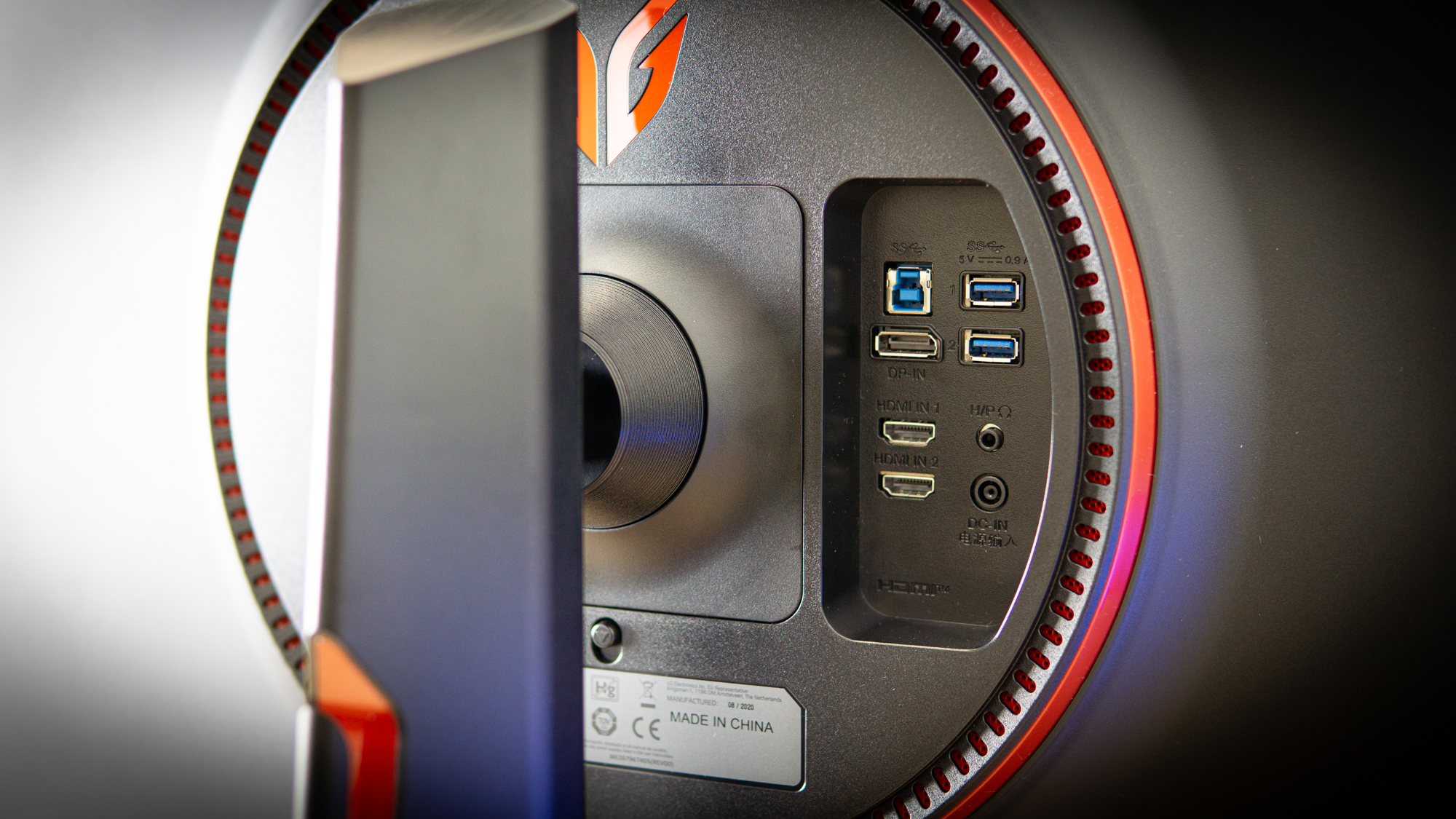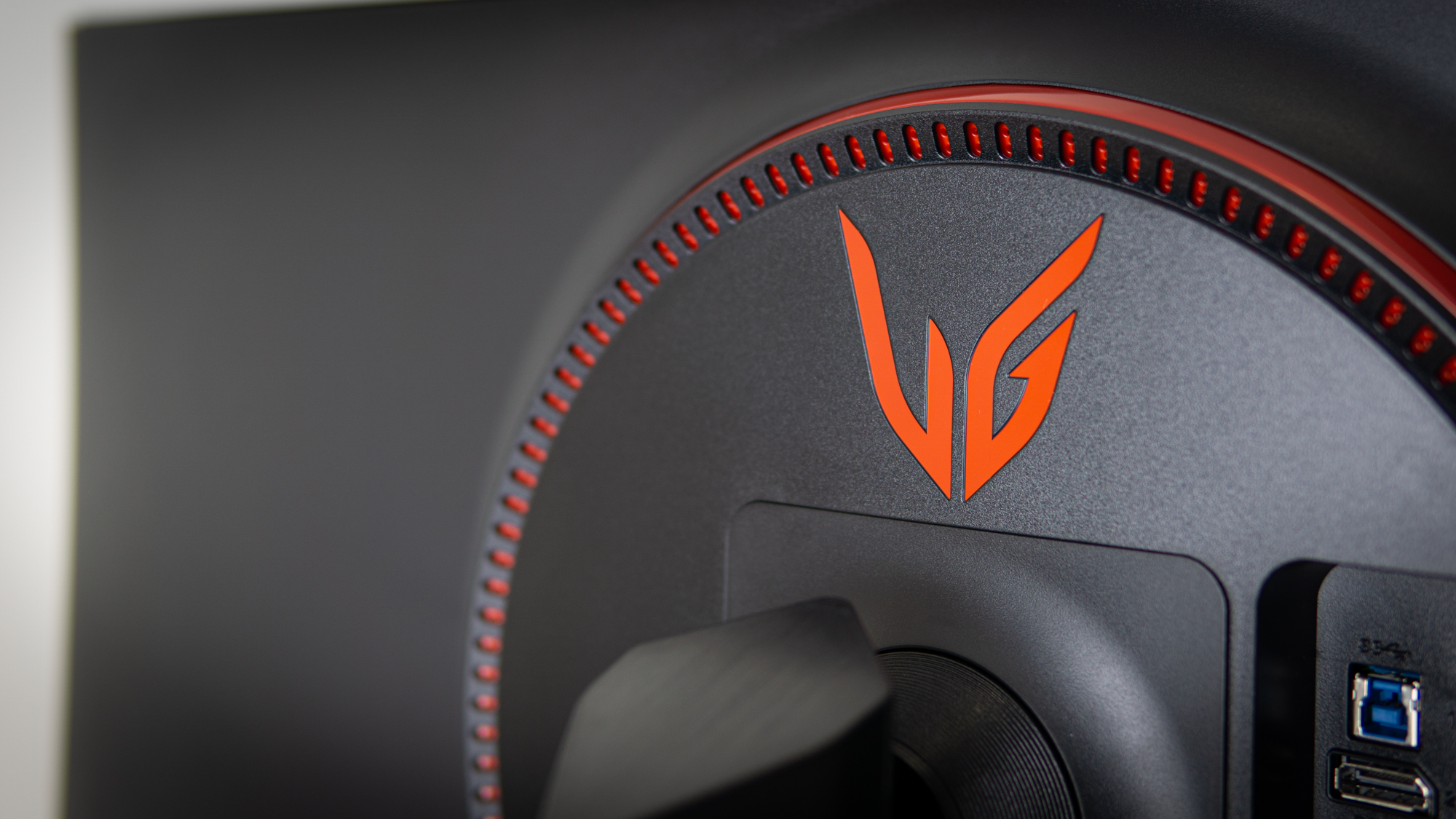- Excellent image quality
- Outstanding motion clarity
- Intuitive, Sharp & Responsive OSD
- Classy looks, if you skip the stand
- Consistent & even curve
- Easily access IO
- Stand is large and unimpressive
- Poor contrast ratio
It’s a great time to buy a monitor. Although it’s still not possible to get the perfect monitor, LG has come close with its 34GN850-B, ticking many of the right boxes on the spec sheet, including a 160Hz refresh rate on its ultrawide-format Nano-IPS panel, 98% DCI-P3 coverage, 1ms response times, Adaptive-Sync, HDR400, and more.
These are impressive specifications. It’s not every day that you see a monitor land these figures for color performance paired with gaming prestige. But there’s a catch. The LG 34GN850 costs twice as much as budget ultrawides that use VA panels, and offers the same size, resolution, and almost the same refresh rate. So where is that money going?
Design
As you unpack the LG 34GN850, you’ll realize that most of your money is going to the panel and its performance. The back of the monitor is made from smooth brittle plastics with a red ring around the mounts and IO.
It’s not over-designed like a lot of gaming hardware is nowadays, but it’s practical and serves the purpose of encasing the monitor, which is all that matters. Our retail sample had the UltraGear logo on the back, though your unit may come with the less garish standard LG emblem.
Flip to the front of the display, and we’re happy to say LG upgrades the finish where it counts. While cheap curved monitors often have unsightly gaps between the panel and the lower bezel due to cost-cutting in manufacturing, LG sticks the lower bezel flush against the panel across its width which, paired with the glossy casing around the top, bottom, and sides of the display, makes the 34GN850 look clean and classy from the front.
The display’s 1900R curve is also more consistent than on cheaper displays, which often have one or two clear bends to achieve their curve. Instead, the LG 34GN850 has a very fluid and even curve across its width, which goes a long way to making the monitor look more expensive and premium.
Chuck the 34GN850 on a simple desk-clamping monitor arm, and you’ve got one classy-looking ultrawide.
You can opt to use the included stand with the monitor, but there are a few problems with it. The stand itself is among the largest monitor stands I’ve come across, to the point where it’s obnoxious. It brings the monitor too far forward on a desk for comfortable use.
This makes the monitor look larger and more immersive (which is probably why manufacturers do it), but for productivity work, competitive gameplay, and eye comfort, you’re going to want the display a bit farther back.
Pair that with the stand’s tacky look, prone-to-wobble design, and ineffective attempt at cable management, and you’ll find that spending an extra $60 on a simple desk-clamping monitor arm is not a crazy thought. That’s disappointing, given the price of this monitor.
If you do choose to use the stand, you can expect the monitor will sit about 12 inches forward from the rear of the stand. It comes with height and tilt adjustments, but it does not swivel or rotate to portrait.
Ports & Controls
Now that we’ve covered the drawbacks of the 34GN850, it’s time to get into the good stuff. It starts with the on-screen controls. As with past monitors from LG, the controls are impressive.
It’s all controlled with a single directional toggle at the bottom of the monitor, and it’s extremely easy to use. Push it forward or backwards to jump straight into the brightness controls, or left and right for volume. If you press it, you trigger the menu selection tool, which takes you to the Display’s main OSD. This menu is clear, crisp, and responsive, which isn’t something we can say about a lot of monitors.
As someone who changes brightness a lot, I especially appreciate the immediate one-click access to brightness controls.
Inside you’ll find five sub-menus: Game Mode with a handful of image presets, Game Adjust where you can select the overclock setting (On for 160 Hz, off for 144 Hz), Adaptive-Sync, Black Stabilizer, and a crosshair.
In the picture-adjust sub-menu you’ll find brightness, contrast, sharpness, gamma, color temperature, and fine-tuning controls for the colors, and finally, the Input and General sub-menus provide you with general system settings.
You’ll want to switch off the automatic standby feature as by default, it’s set to 4 hours. I wasn’t happy that the monitor tried to turn itself off three times a day.
Unlike most competitors, LG places the rear IO horizontally rather than downwards-facing, which is a good move if you ask me. I’ve never used a monitor that had rear IO that was this easy to access.
Admittedly, it isn’t the most elegant look from behind with cables sticking straight out, but the vast majority of users place the backs of their monitors towards walls anyway.
You’ll want to use the single DisplayPort 1.4a connector to unlock the 144Hz refresh rate and 10-bit color depth, as using one of the two HDMI inputs will limit your maximum refresh rate to 85Hz with 10-bit colors.
You can opt to overclock the display in the OSD to unlock the full 160Hz, but you’ll have to sacrifice either 10-bit colors for 8-bit, or use YUV422 chroma-subsampling while keeping 10-bit colors. That will cause visible fringing around text, so the 8-bit color option is preferable.
If you do a lot of graphics work and only play games occasionally, it’s best to keep the display at 144 Hz with 10-bit colors. But if you favor gaming performance, you’re not losing much by switching to 8-bit colors to get the 160Hz refresh rate. While technically inferior, games still look great on an 8-bit panel.
Finally, the 34GN850 has a two-port USB 3.0 hub, headphone jack, and power is delivered through a modestly sized external brick.
Performance
If you’re buying an ultrawide and you’re after image quality, you’ve come to the right display.
The LG 34GN850 packs a Nano-IPS panel (LG’s spin on Quantum Dots) with 3440 x 1440 resolution. LG promises a DCI-P3 color space coverage of 98%. The wide color gamut creates a rich image that is truly satisfying, but be warned. Your old displays will look quite flat once you’re used to this wide gamut.
The color reproduction, paired with a 160Hz refresh, rate goes to show just how far IPS technology has come.
The static contrast ratio is limited to just 1000:1, as it always has been for IPS, and our testing does show some glow in the corners (see the blue glow in image below). This where IPS is starting to show its age, especially against modern technologies such as OLED screens and VA panels, although those come with their own drawbacks.
We tested the monitor with our Datacolor Spyder X Elite, and found that our retail sample is able to cover 88% of the AdobeRGB space and 94% of the DCI-P3 space, with colors reproduced at a Delta-E (difference from real) of 1.68. The peak brightness we achieved was measured to be 390 nits, with a contrast ratio of 900:1. The best possible contrast reading we saw, at 920:1, was achieved with 75% brightness.
These figures are a hair below the factory spec, so this panel is under-performing a little compared to how it should, but the difference is minor. Gamma performance, on the other hand, was perfect out of the box.
In our test environment, the monitor’s peak brightness of nearly 400 nits was too high for normal use, and we’d expect that to be true for most users. We’d opt to use the monitor around 50 to 75 percent brightness in a room with plenty of ambient light, and at 40 or lower at night.
Calibrating the monitor helped us pull 2% more AdobeRGB color space coverage, but dropped the peak brightness by 5 nits, and reduced the maximum contrast to 840:1. Color accuracy was much better at 0.68, so it’s safe to say that you can benefit from calibrating the monitor if your usage requires this, but if you’re just gaming and don’t need the better color accuracy, you won’t be missing out on much running the monitor on its default settings.
Numbers aside, this is an excellent monitor out of the box and after calibration. Its only weakness is its low contrast ratio, a problem all IPS panels share. You’ll find that annoying if you work or play in a dark room. Otherwise, the LG 34GN850 delivers a sharp image with beautiful yet realistic colors. You’ll only find better image quality from the best 4K and 5K monitors, which are often even more expensive.
Gaming performance
The ultrawide resolution of 3440 x 1440 is nothing new, but it’s a great fit for gaming. Think of it like a 27-inch QHD monitor (2560 x 1440) stretched wide.
Pair that with the fact that this ultrawide resolution is still nowhere near the pixel count of 4K displays, and it strikes a good compromise between extreme sharpness and achievable performance. Nvidia’s new RTX 3080 can easily power this display, and in most games, an older high-end GPU like the GTX 1080 Ti or Radeon VII will be enough. A last-gen mid-tier GPU, like the AMD Radeon 5700XT or Nvidia GTX 2070 Super, would work as well.
We tested the monitor with an Nvidia RTX 2080 Super graphics card, and the results were impressive. Horizon Zero Dawn at Ultra settings ran at around 65 to 70 FPS in-game depending on whether the graphics card was overclocked or not, and while this is nowhere near the high 160 Hz refresh rate, Adaptive-Sync (this display is also certified G-Sync Compatible), kept gameplay smooth.
This game makes great use of the monitor’s wide color gamut. You know the moment just before sunset, often called the golden hour, when the light filters to a beautifully diffuse shade of red? The 34GN850 easily handled these intense colors in Horizon Zero Dawn. I’ve never seen anything like it from a PC.
It was mind-boggling just how fast, buttery-smooth, and clear the image was at 160 Hz.
Switch to a fast-paced title such as Insurgency Sandstorm, or the ever-so-popular Destiny 2, and the fast refresh rate comes into play. For these games, I set the graphics settings to lowest to make the best use of the 160Hz refresh rate. Motion clarity was impressive, mostly removing the ghost-like trail that often follows and obscures a fast-moving object.
Samsung’s G7 series is the only monitor I’ve tested that outperforms this LG. Generally speaking, you can expect better performance from 240Hz or 360Hz displays, but most of these displays are 24-inch or 27-inch 16:9 monitors.
Paired with a 1000Hz gaming mouse and a fast keyboard, I was landing shots I normally never landed. I’m by no means a hardcore gamer — the real world often keeps me to busy to play — but I felt more skilled playing on this ultrawide.
HDR performance
The 34GN850 has VESA DisplayHDR400 certification, which is the lowest tier of HDR monitors come can carry. That already tells you not to count on much.
This monitor doesn’t come with dimming zones, instead raising and lowering the backlighting of the entire monitor based on what needs to be shown on screen. If one spot needs to be very bright, the whole monitor gets brighter. That’s not optimal.
As a result, there just isn’t a large enough difference in visuals to justify the hoops you need to jump through to get it working. So, aside from testing, I left it switched off.

Our Take
The LG 34GN850 is not perfect, but it’s very good. Build quality is certainly a few notches above more budget-friendly displays, image quality is sublime, and motion clarity in fast-paced games at the overclocked 160Hz refresh rate, or even the standard 144Hz, is outstanding.
The 34GN850 is great not only for immersive competitive gaming, but also for productivity. It’s large, has a wide color gamut, accurate colors, and delivers a consistent, uniform, sharp image. If you can live with the IPS drawbacks such as low contrast and visible glow in dark scenes, you’ll fall in love with the LG 34GN850.
Is there a better alternative?
If you’re looking for a monitor that’s only for gaming and absolute (color) performance isn’t as critical, the AOC CU34G2X with its VA panel gets you most of the way towards the LG’s experience. However, its build quality is lower, color accuracy is not as impressive out of the box, and its motion clarity is significantly worse.
LG’s 34CB99 offers a Nano-IPS panel and format with great colors for editing at two thirds the price, but lacks the high-refresh rate gaming prowess the 34GN850 has. It’s a good choice if gaming is not important to you, or you only play slow-paced games (like Civilization VI or Microsoft Flight Simulator).
The only monitor that has similar performance in gaming and productivity is the Alienware AW3420DW, which has a nicer casing and stand, but doesn’t match the LG for performance, and has a notably higher price tag.
How long will it last?
The monitor itself should last as long as any monitor does: a minimum of 5 years, though LG will only cover it with a warranty for the first year.
It’s possible that the monitor’s IPS panel will seem out of date soon, as OLED is much better. On the other hand, OLED has existed for some time now, and monitors have still not adopted it because of issues with price, availability, and image retention. It’s possible IPS technology will remain relevant for years to come.
Should I buy it?
Yes. Right now, there just isn’t a better alternative when you want an ultrawide that’s good for both work and play. Just note that LG can’t seem to keep up with demand, so getting your hands on the LG 34GN850 might to be a bigger challenge than you would think, and you may need to pay up to $100 over MSRP.











